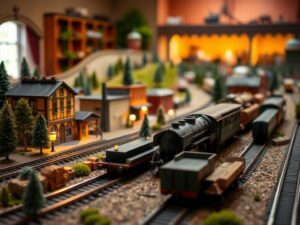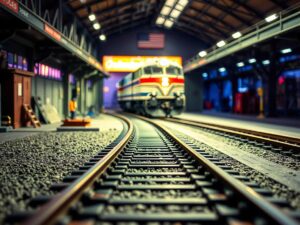Exploring DCC-Compatible Accessories for HO Scale Layouts
Exploring DCC-Compatible Accessories for HO Scale Layouts
Exploring DCC-Compatible Accessories for HO Scale Layouts
Hey there fellow rail fans! Itâs your friend here, ready to dive into the world of model railroading â specifically focusing on bringing those amazing HO scale layouts to life with fantastic DCC-compatible accessories. For those unfamiliar, DCC stands for “Digital Command Control,” a system that revolutionizes model railroading by allowing you to individually control the speed, direction, and functions (think headlights, ditch lights, or even a sound horn!) of your locomotives and some rolling stock. But did you know that DCCâs magic extends beyond just the trains?
With DCC-compatible accessories, we can inject a whole new level of realism and interactivity into our layouts. Think bustling intersections with automated gates, factories belching steam, and buildings reacting to approaching trains. Let’s explore the exciting realm of these digital add-ons and see how they can elevate your HO scale modeling experience.
Understanding the Power of DCC Accessories
Remember those childhood toy sets? Pushing buttons and flicking switches might get the basics done, but it lacked the nuanced control we crave in a hobby like model railroading. This is where DCC accessories step up to bat! Imagine controlling turnouts (switches), crossing gates, lights, and more, all independently and digitally. Suddenly, you’re not just running trains â youâre creating an entire interactive world with every train arrival or departure triggering dynamic scenes.
Letâs Dive into Some Common DCC-Compatible Accessories:
1. DCC-Controlled Turnouts (Switches): The lifeblood of any layout!
DCC turnouts provide precise, remote control over these vital railroad junctions. Say goodbye to fiddling with manual levers every time a train needs to switch tracks! DCC systems use an electronic signal (typically PWM – Pulse Width Modulation) to send commands directly to the turnout motor.
Features:
- Remote Operation: Control turnouts from your command station or even handheld throttle.
- Multiple Programming Options: Set up routes, pre-determined switching patterns, and customize their operation.
- Feedback: Many DCC-compatible turnouts include a feedback system to tell you if the switch is indeed thrown in the desired position â vital for maintaining a smooth running layout!
2. Crossing Gates & Warning Lights:
Imagine a classic road crossing on your HO scale model! DCC controlled crossing gates can rise and fall in sync with approaching trains, complete with warning lights that flash and a distinctive clanging bell.
Features:
* Realistic Simulation: Add an extra layer of realism and attention to detail.
* Safety Features: Prevent potential derailments by stopping traffic when trains are near.
* Optional Sounds: Some models even feature integrated sound effects for added immersion.
3. Sensors: These tiny, but mighty gadgets open up a world of possibilities for automating your layout!
Types of DCC-Compatible Sensors:
- Presence Detection: Determine if a locomotive or car is present in specific zones on the track.
- Occupancy Detection: Identify when a section of track is occupied, allowing for sophisticated train scheduling and interlocking systems.
- Track Circuits: Create virtual sections within your layout to manage signal lights, automate turnouts, and monitor train movements.
4. Signals & Beacons: Control traffic flow with realistic looking signals that mimic the operation of their full-sized counterparts!
Features:
- Dynamic Signaling Systems: Implement realistic aspects like block signals, interlocking systems, and passing track signals.
- Signal Head Varieties: From traditional semaphore style to modern LEDs, choose signal heads to match your layout aesthetic.
5. Lighting Effects: Add an ethereal touch to your landscapes with DCC-controlled lights!
Features:
* Adjustable Brightness & Color: Create day, night, and special effect lighting for added visual impact.
6. Power Distribution Systems: For larger layouts, a centralized DCC power distribution system provides reliable voltage regulation to ensure smooth train operation and protect your electronics.
Diving into HO Scale Specific Considerations
When selecting DCC-compatible accessories for your HO scale layout, pay close attention to the following:
- DCC Brand Compatibility: Ensure that all your chosen accessories work with your particular DCC command station brand (e.g., Digitrax, Bachmann E-Z Command).
- Scale Standards: Stick to genuine HO scale components (typically 1:87 ratio) to maintain visual consistency and ensure smooth interaction between trains and scenery.
Helpful Tips for New Model Railroaders
- Start Small & Build Up Gradually: Begin with a few essential DCC-compatible accessories like turnouts and some simple signals, then gradually expand your system as you gain confidence and experience.
-
Choose High-Quality Components: Investing in durable and reliable accessories from reputable brands will pay dividends in the long run. Look for components with feedback mechanisms to minimize wiring headaches.
-
Research & Learn: Dive into online forums, model railroad magazines, and instructional videos dedicated to DCC operations. Thereâs a wealth of knowledge out there!
- Don’t Be Afraid to Experiment: Have fun exploring the capabilities of your DCC system. Try different lighting scenarios, automated routing, and sound effects â let your creativity flow!
Conclusion
DCC-compatible accessories take your HO scale model railroading experience from hobby to high-definition entertainment!
The possibilities for adding realism, interactivity, and customization are truly endless. So dive in, experiment with different add-ons, and remember â there’s always something new to learn in the wonderful world of model railroads! Keep those tracks running smoothly!
Let me know if you have any questions or topics youâd like me to explore further! I’m here to help make your modeling journey as rewarding and fun as possible.




